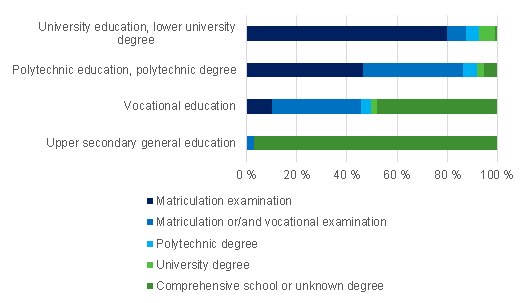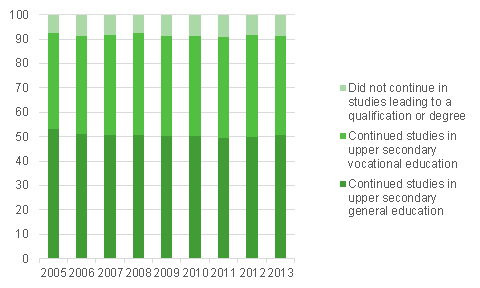Published: 12 February 2015
Every tenth new tertiary level student has previously completed a tertiary degree
According to Statistics Finland’s education statistics, nearly 12 per cent of those having started studies for a lower university degree and good eight per cent of those having started polytechnic degree studies in 2013 had already completed a tertiary degree. In all, 47 per cent of new polytechnic degree students and 80 per cent of lower university degree students had completed only the matriculation examination.
New students by education and prior degree or qualification in 2013, %

In 2013, 24 per cent started studies for a polytechnic degree with only a vocational qualification, 15 per cent with a combination of the matriculation examination and a vocational qualification (vocational secondary qualification, post-secondary qualification, tertiary level qualification), six per cent with a previously completed polytechnic degree and three per cent with a university degree.
In 2013, eight per cent of new students started university degree studies with only a vocational qualification, over five per cent with a polytechnic degree and six per cent with a university degree.
Nearly one-half of vocational education students come directly from comprehensive school
A total of 368,300 young people or adults applied to education starting in 2013. Fifty-six per cent of them started studying. In these figures, the applicant and the new student are included once in the numbers for the educational sector. Ninety-three per cent of those having applied for upper secondary school education started studies. Ninety-seven per cent of the applicants and new students in upper secondary school education had completed only comprehensive school.
Eighty-one per cent of the applicants to upper secondary vocational education started studies. Fifty per cent of the applicants and 48 per cent of the new students in vocational education had completed only comprehensive school.
The numbers of applicants to tertiary education grew compared with the year before. Over 10,000 more applied to polytechnics and 3,000 more to universities. In all, 32 per cent of the applicants to polytechnic education and 29 per cent of the applicants to university education started their studies.
Immediate continuation of studies became more difficult for completers of the 9th grade of comprehensive school and new passers of the matriculation examination
In all, 8.9 per cent of the completers of the 9th grade of comprehensive school and 63.7 per cent of the new passers of the matriculation examination were left outside further studies leading to a qualification. The share of those left outside further studies grew for both completers of comprehensive school and new passers of the matriculation examination in comparison with the previous year.
Direct transition to further studies of completers of the 9th grade of comprehensive school 2005–2013, %

In 2013, the total number of completers of the 9th grade was 59,600, which is 1,500 lower than one year earlier. Of them, 51 per cent continued studies in upper secondary school education and 40 per cent in upper secondary vocational education. The remaining nine per cent did not immediately continue studies leading to a qualification. However, they may have continued studies not leading to a qualification, such as additional education of comprehensive school (tenth grade) or counselling and preparatory studies for initial vocational education (Career Start). Nearly all completers of the 9th grade of comprehensive school applied to further studies, merely 1.5 per cent did not apply to any studies at all.
The number of new passers of the matriculation examination was 32,100 in 2013. Eighteen per cent of them entered university education and 14 per cent polytechnic education in the autumn of the year they passed the exam. Four per cent entered upper secondary vocational education. Clearly more than one-half, nearly 64 per cent, of the passers of the matriculation examination did not continue studies in the year of the matriculation examination. The share of those left outside further studies has been growing for several years and it increased further now. This happened although the share of those not having applied at all decreased. Eighty-one per cent of the new passers of the matriculation examination applied to further studies. The share of applicants was over four percentage points higher than one year earlier.
More detailed time series data on the immediate continuation of studies among completers of the 9th grade of comprehensive school and passers of the matriculation examination by location area of the educational institution are available in the database tables .
Source: Education. Statistics Finland
Inquiries: Anna Loukkola 029 551 3678, koulutustilastot@stat.fi
Director in charge: Riitta Harala
Publication in pdf-format (270.7 kB)
- Tables
-
Tables in databases
Pick the data you need into tables, view the data as graphs, or download the data for your use.
Appendix tables
- Appendix table 1. Direct transition to further studies of completers of the 9th grade of comprehensive school 2005 - 2013 (12.2.2015)
- Appendix table 2. Direct transition to further studies of passers of the matriculation examination 2005 - 2013 (12.2.2015)
- Appendix table 3. Applicants to education by educational sector and prior education in 2013 (12.2.2015)
- Appendix table 4. New students by education and prior highest qualification in 2013 (12.2.2015)
- Appendix table 5. Simultaneous application to different levels of education and new students simultaneously at different levels in 2013 1) (12.2.2015)
Updated 12.2.2015
Official Statistics of Finland (OSF):
Entrance to education [e-publication].
ISSN=1799-4527. 2013. Helsinki: Statistics Finland [referred: 18.12.2025].
Access method: http://stat.fi/til/khak/2013/khak_2013_2015-02-12_tie_001_en.html

